Chris Loehmer Kincaid's Blog, page 166
June 16, 2013
I'm riding in what?
When I went to Kenya the first time, back in 2006, the highlight of our trip was the stay in Massailand. We worked and played for several days at Mosiro, running a medical clinic and doing health education for the Maasai who live there. This time in Kenya, my daughter Val and I visited a different place in Maasailand. The town was called Saikeri and the road there was as tenuous, though shorter, than the road to Mosiro. But upon arrival, just like Mosiro, I instantly knew that the trip had been worth it. This is how we got to Saikeri. We left the volunteer house around ten in the morning, took a matatu to Nakumatt Junction and then a city bus to Ngong. Ngong is a bit like Narok – very busy, with a mix of modern and Maasai. It is the last vestige of civilization before heading down out of the Ngong Hills and into the Rift Valley.

Our ride to Saikeri, Maggie, said she would meet us at the corner in front of Barclay Bank. As if she had nothing else to do and nowhere else to go, she suggested we stop at a café for chai tea and samosas. I’d had chai at Nakumatt Junction and had been so disappointed. It tasted like the chai which I made at home and nothing like what I remembered drinking in Kenya the last time. Now here at Ngong, I thought, finally, really chai. But it wasn’t to be; this still didn’t taste right. At least the beef samosas were good. After visiting and finishing our snack, Maggie directed us to the Naivas grocery store so we could get some last supplies to take with us into the Bush. Maggie left us there while she went off to run some errands. With our meager purchases crammed in our backpacks we waited patiently at the designed spot and soaked up the ambience of Ngong. Ok, there is no ambience in Ngong, just a lot of people and traffic, dust and noise.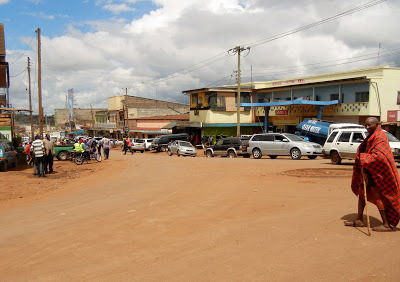
Finally Maggie came back and took us to the vehicle we were to ride out to Saikeri. It was a two-wheel drive, compact, ancient Toyota pickup. The bed was half-full of supplies and Maggie suggested that I ride in the cab with her. Val naturally thought I should get the full Kenyan experience, so suggested I ride in the bed of the truck with her. That sounded fine to me. How bad could it be? I grew up riding in the back of my dad’s Chevy. Oh, but it got bad. First off, Maggie took off to run another errand. While we waited, people kept coming up to the truck and setting boxes and bags in the back of it. Then they would just walk off. I kept asking myself, do they know what they are doing and where this stuff is going?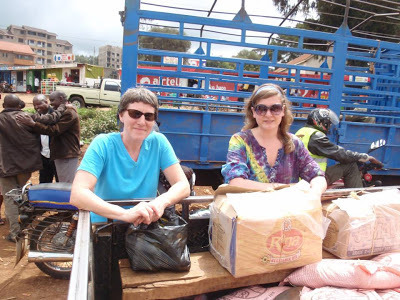
Then two older Maasai women came along and crawled into the bed of the truck. Then another hundred pounds worth of supplies were dropped in. Two more Maasai women and a Maasai girl clambered in. I said, “Val, maybe we better get in before they run out of room.” So we sat on the boards which were across the wheels on each side and waited some more, while more supplies and more people crowded in. All total, by the time we left, an hour later, there were nine people in the bed of the truck, two boys on the roof of the cab and three people in the cab, along with hundreds of pounds of boxes, bags and loaves of bread. There was no longer any room in the back of the truck, so we road on the side hanging for dear life to the thin railing running along the box.
After being in Ngong for what had to be hours (this is why you don't wear a watch in Kenya, it just makes for more frustration), it was time to head into the Bush. Check back on Tuesday to see how that went.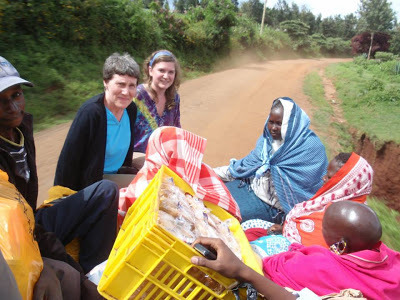

Our ride to Saikeri, Maggie, said she would meet us at the corner in front of Barclay Bank. As if she had nothing else to do and nowhere else to go, she suggested we stop at a café for chai tea and samosas. I’d had chai at Nakumatt Junction and had been so disappointed. It tasted like the chai which I made at home and nothing like what I remembered drinking in Kenya the last time. Now here at Ngong, I thought, finally, really chai. But it wasn’t to be; this still didn’t taste right. At least the beef samosas were good. After visiting and finishing our snack, Maggie directed us to the Naivas grocery store so we could get some last supplies to take with us into the Bush. Maggie left us there while she went off to run some errands. With our meager purchases crammed in our backpacks we waited patiently at the designed spot and soaked up the ambience of Ngong. Ok, there is no ambience in Ngong, just a lot of people and traffic, dust and noise.

Finally Maggie came back and took us to the vehicle we were to ride out to Saikeri. It was a two-wheel drive, compact, ancient Toyota pickup. The bed was half-full of supplies and Maggie suggested that I ride in the cab with her. Val naturally thought I should get the full Kenyan experience, so suggested I ride in the bed of the truck with her. That sounded fine to me. How bad could it be? I grew up riding in the back of my dad’s Chevy. Oh, but it got bad. First off, Maggie took off to run another errand. While we waited, people kept coming up to the truck and setting boxes and bags in the back of it. Then they would just walk off. I kept asking myself, do they know what they are doing and where this stuff is going?

Then two older Maasai women came along and crawled into the bed of the truck. Then another hundred pounds worth of supplies were dropped in. Two more Maasai women and a Maasai girl clambered in. I said, “Val, maybe we better get in before they run out of room.” So we sat on the boards which were across the wheels on each side and waited some more, while more supplies and more people crowded in. All total, by the time we left, an hour later, there were nine people in the bed of the truck, two boys on the roof of the cab and three people in the cab, along with hundreds of pounds of boxes, bags and loaves of bread. There was no longer any room in the back of the truck, so we road on the side hanging for dear life to the thin railing running along the box.
After being in Ngong for what had to be hours (this is why you don't wear a watch in Kenya, it just makes for more frustration), it was time to head into the Bush. Check back on Tuesday to see how that went.

Published on June 16, 2013 08:41
June 13, 2013
Home Away From Home
I know that I told you a little about the volunteer house where we stayed in Kenya, but I thought I should fill you in on it a bit more. I don’t know the whole story of the house’s evolution, but I know that it has only been operational a few months. The ground floor consists of the main living space, which doubles as dining room, kitchen, TV room, and even a meeting room during the day.
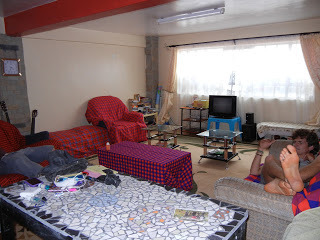
The window of this room overlooks this fine yard belonging to the neighbors, where roosters live and crow each morning by four AM. (Picture taken from the roof.)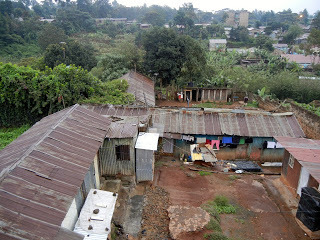
Outside the front door, someone set up a dart board, where it seemed that someone was always throwing darts.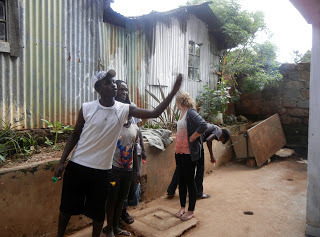
Nothing wrong with that, except that my bedroom window is right there, to the left of where the dart board sits. (When no one is playing, they bring it in the house.)
I showed you a picture of our bedroom already. Nothing fancy. Not very big, but big enough.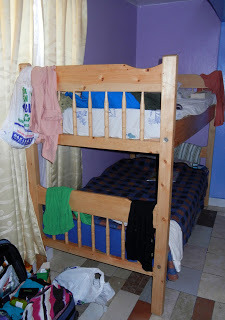
We even had an attached bathroom. Too bad the fixtures weren’t connected yet, but at least it was a space to store our toiletries.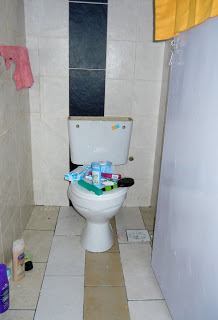
The bathroom we used was on the other end of the house. The sink was in the large storage room next to the main living space. The bathroom itself was just the toilet and shower – all in one little space. (I pulled this picture off of Izzo’s Facebook page. I don’t know why I didn’t take more pictures of my own.)
The cool place was the unfinished second floor.
And the coolest place was the roof – or at least the views from the roof.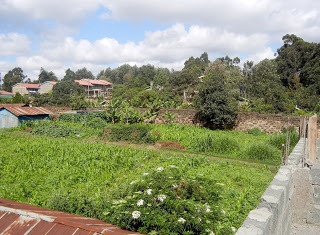
Now you know a little of what my home away from home looked like and where Val is staying for another month and a half.

The window of this room overlooks this fine yard belonging to the neighbors, where roosters live and crow each morning by four AM. (Picture taken from the roof.)

Outside the front door, someone set up a dart board, where it seemed that someone was always throwing darts.

Nothing wrong with that, except that my bedroom window is right there, to the left of where the dart board sits. (When no one is playing, they bring it in the house.)

I showed you a picture of our bedroom already. Nothing fancy. Not very big, but big enough.

We even had an attached bathroom. Too bad the fixtures weren’t connected yet, but at least it was a space to store our toiletries.

The bathroom we used was on the other end of the house. The sink was in the large storage room next to the main living space. The bathroom itself was just the toilet and shower – all in one little space. (I pulled this picture off of Izzo’s Facebook page. I don’t know why I didn’t take more pictures of my own.)

The cool place was the unfinished second floor.

And the coolest place was the roof – or at least the views from the roof.

Now you know a little of what my home away from home looked like and where Val is staying for another month and a half.
Published on June 13, 2013 17:30
June 11, 2013
Refuges in your own homeland
One of the groups which my daughter most wants to work with are the people living in the IDP camps outside of Nairobi.One day while I was in Kenya we visited the IDP camp at Maai Mahu. Talk about heartbreaking. Most of these families were displaced following post-election violence in 2007. Before that they had decent homes and jobs. But when the political party which lost the presidential election challenged the results, violence broke out first in Kiberia slum and then throughout Kenya. Over a half million people were forced to leave their homes or lose their lives and when things quieted down, they had no place to return to. Their homes had either been destroyed or taken over by someone else.
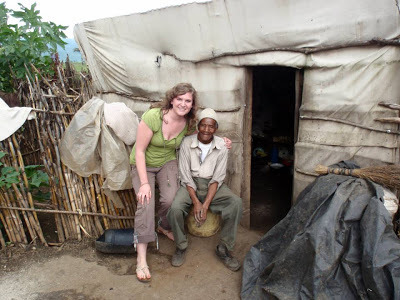
Known as IDP or Internally Displaced Persons, groups of families across the countryside made make-shift shelters, hoping it was temporary. But as the years dragged on, they realized that this was now their home. They had become refuges within their own country.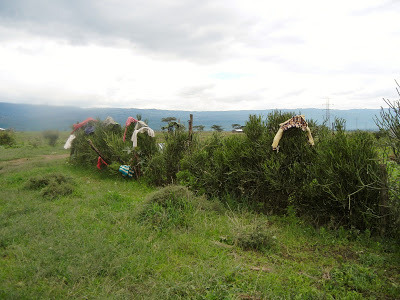 Various outside groups have come in to help them build permanent housing. But the fact remains that they still are displaced. They have little income and little chance to move on to a better life.
Various outside groups have come in to help them build permanent housing. But the fact remains that they still are displaced. They have little income and little chance to move on to a better life.

While Val is in Kenya for three months, she hopes to work mostly with the people in these camps, empowering the women to earn their own income, seeing to the needs of the school children, and finding ways to raise money and awareness once she returns to the States. She’ll be working closely with Gee who has a passion for the people living in the camps.

Known as IDP or Internally Displaced Persons, groups of families across the countryside made make-shift shelters, hoping it was temporary. But as the years dragged on, they realized that this was now their home. They had become refuges within their own country.
 Various outside groups have come in to help them build permanent housing. But the fact remains that they still are displaced. They have little income and little chance to move on to a better life.
Various outside groups have come in to help them build permanent housing. But the fact remains that they still are displaced. They have little income and little chance to move on to a better life.

While Val is in Kenya for three months, she hopes to work mostly with the people in these camps, empowering the women to earn their own income, seeing to the needs of the school children, and finding ways to raise money and awareness once she returns to the States. She’ll be working closely with Gee who has a passion for the people living in the camps.

Published on June 11, 2013 16:42
June 9, 2013
Coincidence? I think not?

Yesterday, my friend Phyllis took me to Joyful Noise Christian music fest in Blaine, Minnesota. If you have been following the tales of my trip to Kenya last month, you may be thinking, “so what? We want to hear about Africa”. But hold on to your seats, God is bigger than that.
This festival, like Lifest, is sponsored by Compassion, International. Between two of the performers, someone got up and gave their plug for Compassion and then introduced a young man who had been a sponsored child with Compassion. Owen was from Kenya and he shared a little bit about his life.
When he had finished speaking, the woman who introduced him said that he would be down at the Compassion tent if anyone wanted to talk to him. Phyllis poked me. “Let’s go, you have to meet him.”
We wound our way through the throng of people, blankets and camp chairs. I was immediately greeted by Owen’s warm smile when I got to his tent.
“Hi, I’m Chris,” I opened with, extending my hand. “I just got back from Kenya.”
“Where were you?” he asked, shaking my hand firmly.
“Mostly in Nairobi. We were working with a group called Marafiki.”
“Marafiki? In Dagoretti?”
“Yes…” It wasn’t possible that he knew of Izzo’s organization.
“I’m from Dagoretti. Did you work with Izzo?”
We talked for a bit, but other people wanted to meet him, so I had to move on. I texted Val in Kenya right away and she was as surprised as I was. Izzo and Gee, who also works with Marafiki, know Owen, and Gee was a Compassion child too.

It seems like it is such a small world. And maybe it is. But I think what is more likely is that it is God’s world and He loves nothing more than bringing His children together.
 Knowing now that Gee was a Compassion child, it's easy for me to understand why he wants to pay it forward. I'll be writing more about him in the coming week.
Knowing now that Gee was a Compassion child, it's easy for me to understand why he wants to pay it forward. I'll be writing more about him in the coming week.
Published on June 09, 2013 13:57
June 6, 2013
Back Packs
I really should back up once again. Have I even ever told you anything about the volunteer organization my daughter and I worked through while we were in Kenya? MarafikiCommunity was established around the time Val was there in 2010. Izzo, who runs the organization, initially started the group to help the people displaced by violence following the 2007 presidential election (more on that another day). From those simple beginnings, Izzo’s group has spread out in several directions, sending volunteers to schools, orphanages, hospitals and clinics as well as the IDP camps. A few days after we visited Maggie, Oliver and the children at Agape Hope Center, Val and I were given a daunting task. Izzo asked us to get together backpacks to give to the children at Agape. The storeroom next to Izzo’s house was filled with donated supplies and it was time to start giving them out. Val and I spent nearly two full days going through the storeroom and finding enough backpacks and pens, pencils, erasers, pencil sharpeners, rulers, and notebooks to fill those backpacks. Without nearly enough room to work and no good way to get out of the sun, we muddled through and got the job done.And then we had the immeasurable joy of giving out those backpacks.

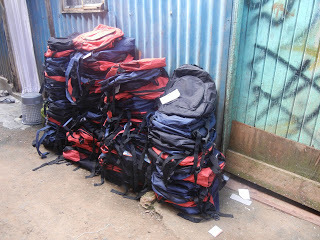
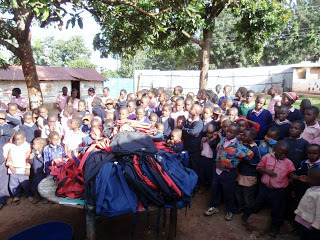
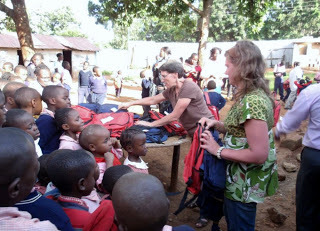
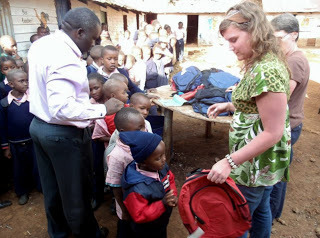
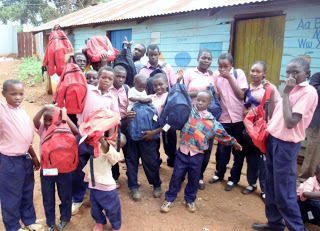






Published on June 06, 2013 16:32
June 4, 2013
Agape means Love
When my daughter Val was in Kenya in 2010, she stayed with Maggie and Oliver for several weeks. Earlier in her six month stay, Maggie had delivered her third child, a beautiful baby girl who they named Beautiful Anna.
Val hadn’t told Maggie and Oliver that she was returning to Kenya, so she called them out of the blue, said she was in Nairobi and asked if we could come for a visit.
Though Beautiful Anna had just been a baby when Val was there three years ago, the precious child bestowed upon Val the warmest greetings. Her name is certainly fitting.
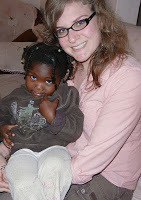 2013
2013
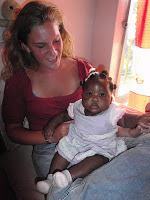 2010
2010
After we visited with Oliver in their home for a while, he took us down to the orphanage which he and his wife run, Agape Hope Center. Attached to the orphanage is a school, which caters to about half orphans and half kids from homes throughout the community.
The school currently runs through grade 8. This year four boys will graduate from 8th grade. For them to go to high school next year, it will cost 28,000 shillings a piece, which is the average yearly income of many Kenyans. Oliver is hoping to open a high school at the orphanage to serve these kids. It would be cheaper to hire four teachers, and then they could offer high school to other kids and get an income from that. But that all takes money up front.
Looking around the grounds of the orphanage and school, it was obvious that the money would be hard to come back. My heart goes out to those graduating eighth graders and their prospects for next year.
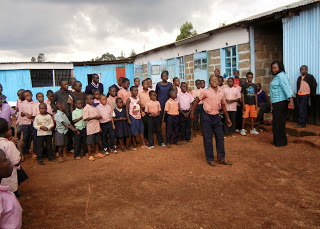
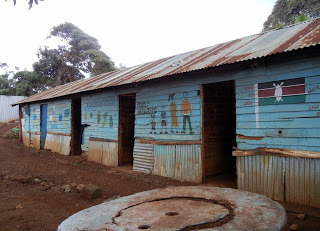
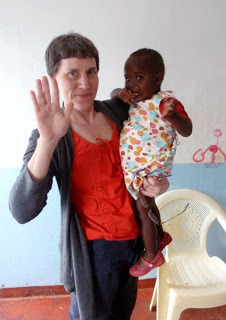
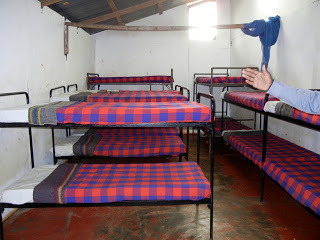

Val hadn’t told Maggie and Oliver that she was returning to Kenya, so she called them out of the blue, said she was in Nairobi and asked if we could come for a visit.
Though Beautiful Anna had just been a baby when Val was there three years ago, the precious child bestowed upon Val the warmest greetings. Her name is certainly fitting.
 2013
2013
 2010
2010After we visited with Oliver in their home for a while, he took us down to the orphanage which he and his wife run, Agape Hope Center. Attached to the orphanage is a school, which caters to about half orphans and half kids from homes throughout the community.
The school currently runs through grade 8. This year four boys will graduate from 8th grade. For them to go to high school next year, it will cost 28,000 shillings a piece, which is the average yearly income of many Kenyans. Oliver is hoping to open a high school at the orphanage to serve these kids. It would be cheaper to hire four teachers, and then they could offer high school to other kids and get an income from that. But that all takes money up front.
Looking around the grounds of the orphanage and school, it was obvious that the money would be hard to come back. My heart goes out to those graduating eighth graders and their prospects for next year.





Published on June 04, 2013 11:22
June 2, 2013
Nakumatt Junction, What's your function?
Yes, I know. I am still writing about my first day in Africa. I need to get on with this, don’t I? As promised, I will start by telling you where the nasty little matatu took us.The Nakumatt is the Kenyan equivalent of Walmart. They sell everything from food to toiletries to dishes to clothes. Wandering the aisles, it was easy to forget where I was, until I looked more closely at the labels. Yes, everything was equivalent to what we have here in the States, but some things still caught me off guard.
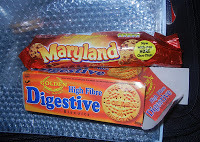
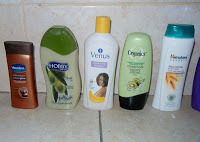
Especially the prices. 365 shillings for a bottle of shampoo. Oh, hold it, I guess that is just under four US dollars, so I guess that isn’t quite so outrageous. After we bought a few supplies, Val went to the phone store to activate her Kenyan phone, while I wandered around Nakumatt Junction, a mall just like we have back home. Again, here I could buy anything I needed. A bookstore, a jewelry store, lots of clothing stores – some familiar, most not. A couple banks, a few ATMs. Since Val was there in 2010, they even added a Kentucky Fried Chicken. Every time our matatu was bringing us here, I would watch for the colonel’s bucket, notifying me that it was time to get off the bus. That first day, and a few times after that, we wound up at the Java House. We ordered chai tea and Val brought her laptop out of her backpack. They have free WiFi at the Java House. And after the waitress brought us our tea, she never came back to bug us, guilt us into hurrying along. That first day we weren’t there long, but on a different day, we sat there for two hours, posting pictures on Facebook.
The longer I was in Kenya, the more comfortable I felt in my own skin. I accepted all of the Africans surrounding me, with their skin color varying from deep tan to chocolate to near black. When I was at the Java House, where a vast array of nationalities, languages and colors ate and drank, I felt more out of place with my pale skin than I did among the Kenyans. I was in Africa and should be surrounded by dark skinned people; I felt like I was in the wrong place when the skin of most people gave away their origin of birth as European, Asian or North American.


Especially the prices. 365 shillings for a bottle of shampoo. Oh, hold it, I guess that is just under four US dollars, so I guess that isn’t quite so outrageous. After we bought a few supplies, Val went to the phone store to activate her Kenyan phone, while I wandered around Nakumatt Junction, a mall just like we have back home. Again, here I could buy anything I needed. A bookstore, a jewelry store, lots of clothing stores – some familiar, most not. A couple banks, a few ATMs. Since Val was there in 2010, they even added a Kentucky Fried Chicken. Every time our matatu was bringing us here, I would watch for the colonel’s bucket, notifying me that it was time to get off the bus. That first day, and a few times after that, we wound up at the Java House. We ordered chai tea and Val brought her laptop out of her backpack. They have free WiFi at the Java House. And after the waitress brought us our tea, she never came back to bug us, guilt us into hurrying along. That first day we weren’t there long, but on a different day, we sat there for two hours, posting pictures on Facebook.
The longer I was in Kenya, the more comfortable I felt in my own skin. I accepted all of the Africans surrounding me, with their skin color varying from deep tan to chocolate to near black. When I was at the Java House, where a vast array of nationalities, languages and colors ate and drank, I felt more out of place with my pale skin than I did among the Kenyans. I was in Africa and should be surrounded by dark skinned people; I felt like I was in the wrong place when the skin of most people gave away their origin of birth as European, Asian or North American.
Published on June 02, 2013 05:42
May 30, 2013
I'm not in America anymore
Tuesday morning! My first full day in Kenya! What are we going to accomplish today, I woke up wondering, as I wandered into the main room to see what was for breakfast. I wish I could tell you what was for breakfast, but I don’t remember. Every morning around eight, our house mom, Momma Bishop, also called Momma Sally, brought in a thermos of hot milk. I know - ick. Most of the other volunteers dumped instant coffee or tea into their cup-full, and once in a while there was some powdered chocolate in the house. I just drank my hot milk straight each morning. This was something new to me, the girl from the dairy state who only drinks her milk ice-cold and preferably skim. But I can adapt. And that’s what a trip to a third world country is most about. Adapting. Along with the thermos of milk, Momma Bishop usually brought a couple loaves of store-bought bread. Some days she also brought French toast, scrambled eggs, or mandazi. Mandazi is considered an East African donut. Fried and sweet – I need to make me some of these sometime soon. After breakfast (I think that first day I made toast and burned it), Val and I walked down to the corner to catch a matatu to Nakumatt Junction.
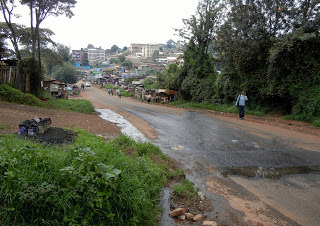 The road at the end of our driveway
The road at the end of our driveway
I suppose you want that explained.A matatu is a nasty form of public transportation, but they are cheap and they go all over. They are a twelve-passenger van. I’m at a loss as to how to describe it beyond that!Ok, so you stand along the road, and this van whizzes up next to you. A guy jumps out, they call him the conductor. He’s not the driver. I only once really even saw the driver of one of these. He pretty much stays put behind the wheel and doesn’t get involved. Anyway, so the conductor jumps out and asks where you are going. No matter what you say, he says he can take you there. And this is where you have to know what you are doing, because he will try to overcharge you, especially if you are white.Val always told him 30 shillings, and sometimes he accepted that and sometimes he didn’t. I was always like, just pay him and don’t argue. It is not worth it. By the way, 30 Kenyan shillings is about 35 cents. So, you jump in this smelly little bus and music is usually blaring, it seemed like either offensive rap with lots of swearing or Christian music. It was weird. But no matter what was playing, it was too loud.So off we go, down the road and the road is bumpy and the bus is crowded and it keeps stopping to pick up more people. Once in a while, when it was already full, the conductor seemed to ask some people to get off so someone else could get on. They spoke in Swahili, so I never was sure if this was really happening, but it sure looked that way. When you get close to your stop, you beat on the side of the bus, and then the conductor beats on the roof too, and somehow with all the noise from the music, the driver actually hears this and usually stops. Not always. But usually. The conductor and the driver must have this all orchestrated somehow. It all seems so chaotic, but somehow they know what they are doing. And no matter how crowded it was, and how many other people got on or off, the conductor knew where us white chicks were getting off. Or at least he did 80% of the time.
Oh, dear, that took up a lot of words. I think I will tell you about the Nakumatt next time. It is much easier to comprehend.
 The road at the end of our driveway
The road at the end of our drivewayI suppose you want that explained.A matatu is a nasty form of public transportation, but they are cheap and they go all over. They are a twelve-passenger van. I’m at a loss as to how to describe it beyond that!Ok, so you stand along the road, and this van whizzes up next to you. A guy jumps out, they call him the conductor. He’s not the driver. I only once really even saw the driver of one of these. He pretty much stays put behind the wheel and doesn’t get involved. Anyway, so the conductor jumps out and asks where you are going. No matter what you say, he says he can take you there. And this is where you have to know what you are doing, because he will try to overcharge you, especially if you are white.Val always told him 30 shillings, and sometimes he accepted that and sometimes he didn’t. I was always like, just pay him and don’t argue. It is not worth it. By the way, 30 Kenyan shillings is about 35 cents. So, you jump in this smelly little bus and music is usually blaring, it seemed like either offensive rap with lots of swearing or Christian music. It was weird. But no matter what was playing, it was too loud.So off we go, down the road and the road is bumpy and the bus is crowded and it keeps stopping to pick up more people. Once in a while, when it was already full, the conductor seemed to ask some people to get off so someone else could get on. They spoke in Swahili, so I never was sure if this was really happening, but it sure looked that way. When you get close to your stop, you beat on the side of the bus, and then the conductor beats on the roof too, and somehow with all the noise from the music, the driver actually hears this and usually stops. Not always. But usually. The conductor and the driver must have this all orchestrated somehow. It all seems so chaotic, but somehow they know what they are doing. And no matter how crowded it was, and how many other people got on or off, the conductor knew where us white chicks were getting off. Or at least he did 80% of the time.
Oh, dear, that took up a lot of words. I think I will tell you about the Nakumatt next time. It is much easier to comprehend.
Published on May 30, 2013 16:44
May 28, 2013
Arrival
My daughter Val and I arrived in Kenya May 6, Monday night, got our Visas, got our luggage and cleared customs without a hitch. Our ride was even there to meet us. I had been so worried that one of those steps would fall through and we wouldn’t be able to leave the airport. I pictured myself being Tom Hanks in the movie “Terminal”. I don't know why I worry about everything so much.Kenya is just so different from the US; it is impossible to explain it to someone who has never been here. Pictures can't explain it, and surely my words can't either. The first thing we noticed as soon as we walked out of the airport was the smell. Driving to our volunteer house, so many odors bombarded us through the open van windows. Diesel exhaust, decaying something or other, smoked meat, and body odor, but not “normal” body odor, more the smell of someone sweating who has been eating something strange. And the traffic. I don't know if there is any place in the world with traffic like Nairobi's. Everyplace is a passing lane and there are no speed limits. The roads have improved a lot since I was here last, the potholes are greatly diminished. But in their place are massive speed bumps. I mean, massive. A small car would barely clear them, and our rear fender hit bottom quite often going over them.
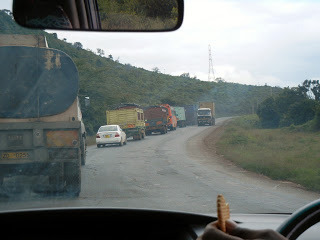 I should have gotten a picture of the passing truck we met right on a curve. It was centimeters from us. By the time we drove through Nairobi after nine Monday night, most of the shops lining the streets were closed. Still there were people everywhere, walking home most likely, if they had homes. The driveway up to our compound was typical for East Africa. One deep rut after another, boulders in the middle of the road and only a foot to maneuver on each side.
I should have gotten a picture of the passing truck we met right on a curve. It was centimeters from us. By the time we drove through Nairobi after nine Monday night, most of the shops lining the streets were closed. Still there were people everywhere, walking home most likely, if they had homes. The driveway up to our compound was typical for East Africa. One deep rut after another, boulders in the middle of the road and only a foot to maneuver on each side.
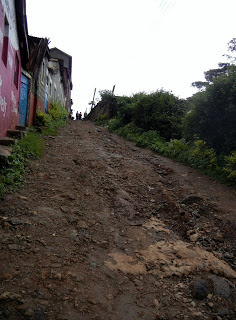 Yes, this really is our driveway.The guest house where we stayed was quite nice. Val and I had a room to ourselves. It was small, with a bunk bed and nothing else. A small bathroom was attached, but the plumbing hadn’t been hooked up. It did at least give us extra space.
Yes, this really is our driveway.The guest house where we stayed was quite nice. Val and I had a room to ourselves. It was small, with a bunk bed and nothing else. A small bathroom was attached, but the plumbing hadn’t been hooked up. It did at least give us extra space.
 Can you guess which bed is mine?After a quick tour of our home away from home, I pretty much crawled right into bed. I fell asleep with my head whirling with thoughts of what the next day would bring.
Can you guess which bed is mine?After a quick tour of our home away from home, I pretty much crawled right into bed. I fell asleep with my head whirling with thoughts of what the next day would bring.
 I should have gotten a picture of the passing truck we met right on a curve. It was centimeters from us. By the time we drove through Nairobi after nine Monday night, most of the shops lining the streets were closed. Still there were people everywhere, walking home most likely, if they had homes. The driveway up to our compound was typical for East Africa. One deep rut after another, boulders in the middle of the road and only a foot to maneuver on each side.
I should have gotten a picture of the passing truck we met right on a curve. It was centimeters from us. By the time we drove through Nairobi after nine Monday night, most of the shops lining the streets were closed. Still there were people everywhere, walking home most likely, if they had homes. The driveway up to our compound was typical for East Africa. One deep rut after another, boulders in the middle of the road and only a foot to maneuver on each side.
 Yes, this really is our driveway.The guest house where we stayed was quite nice. Val and I had a room to ourselves. It was small, with a bunk bed and nothing else. A small bathroom was attached, but the plumbing hadn’t been hooked up. It did at least give us extra space.
Yes, this really is our driveway.The guest house where we stayed was quite nice. Val and I had a room to ourselves. It was small, with a bunk bed and nothing else. A small bathroom was attached, but the plumbing hadn’t been hooked up. It did at least give us extra space.
 Can you guess which bed is mine?After a quick tour of our home away from home, I pretty much crawled right into bed. I fell asleep with my head whirling with thoughts of what the next day would bring.
Can you guess which bed is mine?After a quick tour of our home away from home, I pretty much crawled right into bed. I fell asleep with my head whirling with thoughts of what the next day would bring.
Published on May 28, 2013 16:50
May 26, 2013
Convoluted Plans
After much procrastination, ta-da, here I am blogging again. Ready to tell you every last detail of my recent trip to Kenya. Ok, maybe you don’t want to hear about everything (i.e. diarrhea, lack of toilet paper, etc.), but you know how I am. I just can’t spare you the gruesome adventures of my life. I was going to jump right in and take you straight to Africa. But since I didn’t go straight to Africa, you don’t get to either. When my daughter and I started planning this trip to Kenya, we threw around several different dates. Somehow we came up with the first part of May as the time to depart, which would give Val until the end of July if she was really going to stay for three months. The problem with leaving the first part of May was that I had promised my Kinship kid that I would take her to a Colton Dixon concert in Milwaukee the first Friday in May. Hmm? I thought. How could I best make this work out? My son lives near Milwaukee, which is near Chicago. If we flew out of Chicago we could get the cheapest flights. I came up with the craziest trip itinerary. I mean, when you leave for a two-week trip to a third-world country, don’t you want to leave the comfort of your home and get to your destination by the shortest means? Oh, heavens, no, not me. So, I left home around noon on Friday, May3, picked up my Kinship kid and drove to a suburb of Milwaukee. Checked into our hotel and went to the concert. The next morning, I drove my kid part-way home, where my husband met me for the exchange. He had brought down Val and her suitcase. He picked up the Kid and took her home, while Val and I drove back to Milwaukee. I spent Saturday night at the apartment of one of my son’s friends. I know. Is this complicated? Typical weekend in my life. My son took us to the airport in Chicago the next morning. And our plane left at 4:10 pm. Next stop – Amsterdam.
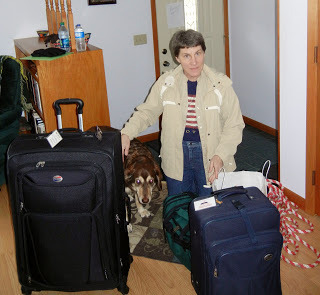 Since this wasn't a one-trip trip, you'll notice the green overnight bag. Also, the white paper bag and the red and white rope which were going to my son's house. The dog thinks he is going with. Last thing to note - the piece of paper taped on the door right behind me says, "PASSPORT". The one thing I absolutely positively must not forget.
Since this wasn't a one-trip trip, you'll notice the green overnight bag. Also, the white paper bag and the red and white rope which were going to my son's house. The dog thinks he is going with. Last thing to note - the piece of paper taped on the door right behind me says, "PASSPORT". The one thing I absolutely positively must not forget.
 Colton Dixon. Was I ever 14-years-old and in love with a pop star? No, I was not.
Colton Dixon. Was I ever 14-years-old and in love with a pop star? No, I was not.
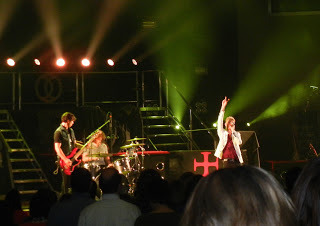 Just one more picture of Colton to appease the Kid.
Just one more picture of Colton to appease the Kid.
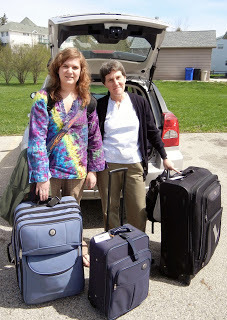 Ok, so now it's finally time to go to the airport.
Ok, so now it's finally time to go to the airport.
 Since this wasn't a one-trip trip, you'll notice the green overnight bag. Also, the white paper bag and the red and white rope which were going to my son's house. The dog thinks he is going with. Last thing to note - the piece of paper taped on the door right behind me says, "PASSPORT". The one thing I absolutely positively must not forget.
Since this wasn't a one-trip trip, you'll notice the green overnight bag. Also, the white paper bag and the red and white rope which were going to my son's house. The dog thinks he is going with. Last thing to note - the piece of paper taped on the door right behind me says, "PASSPORT". The one thing I absolutely positively must not forget.
 Colton Dixon. Was I ever 14-years-old and in love with a pop star? No, I was not.
Colton Dixon. Was I ever 14-years-old and in love with a pop star? No, I was not.
 Just one more picture of Colton to appease the Kid.
Just one more picture of Colton to appease the Kid.
 Ok, so now it's finally time to go to the airport.
Ok, so now it's finally time to go to the airport.
Published on May 26, 2013 05:30



